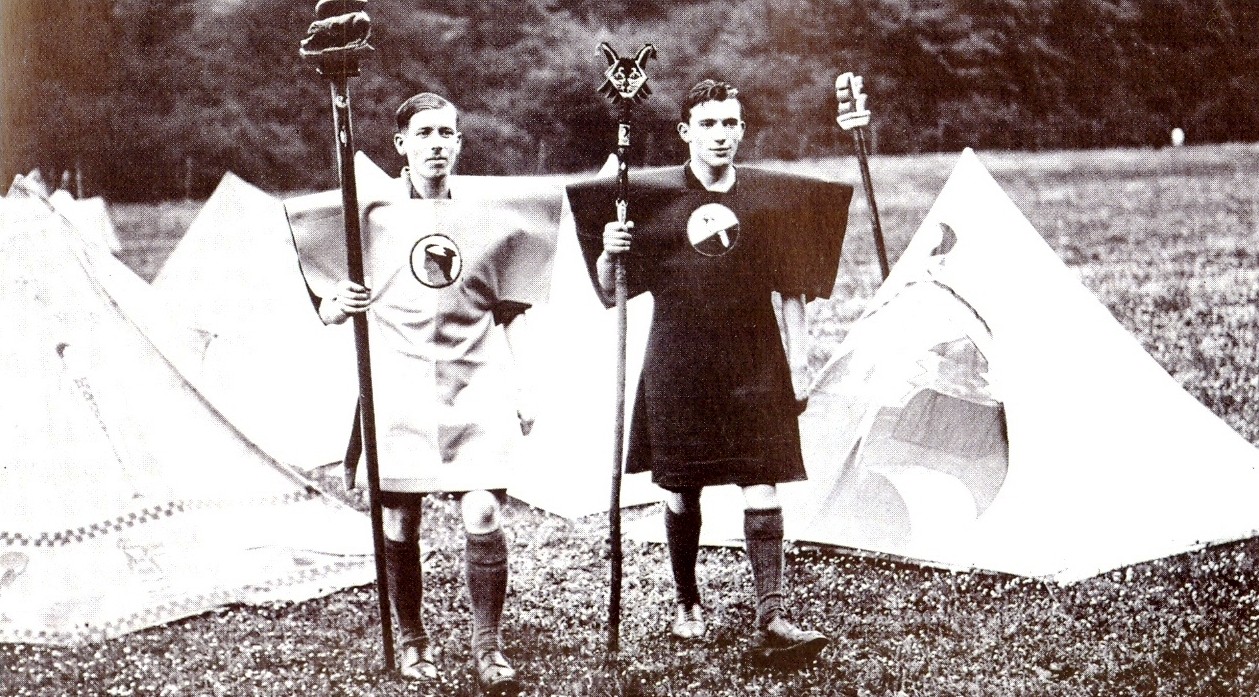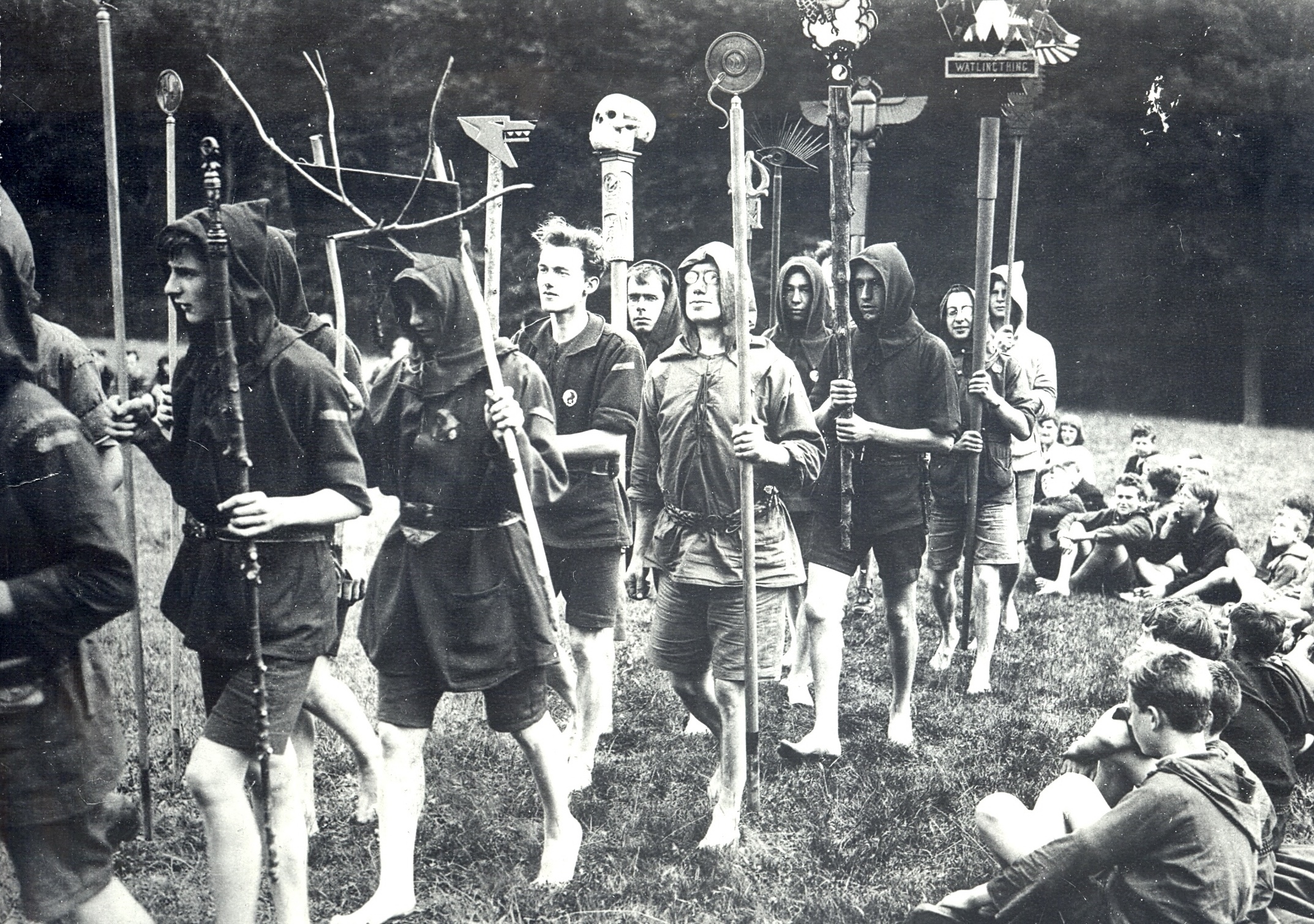England’s Dreaming: John Hargrave & The Occult Roots Of Universal Income

John Hargrave was many things; a pagan cult leader, a brick hurling radical, a pioneer of universal income, a thriller novelist, a psychic healer, an inventor of note, a control freak, and always, too the very end, a utopian dreamer. Political and socially active from the 1920s to the 1940s, Hargrave’s major legacy is his founding of two eccentric, uniquely British organisations; the Kindred of the Kibbo Kift, and The Green Shirts. The first was a back-to-nature youth movement heavy with magical practice and folk symbolism. The second was a militant group (and occasional political party) dedicated to smashing fascism, all whilst violently agitating for universal basic income. Whilst both organisations ultimately collapsed – and have almost entirely faded from public memory- they both have a remarkable resonance with today’s politically and economically fragile society; as much resonance as they ever had with the turbulent interwar England from which they sprang.

Hargrave (sporting his White Fox mask) leading a Kibbo Kift ritual, 1928
The Young John Hargrave
Born in 1894, second son of Gordon Hargrave, a penniless Quaker, John Hargrave had an unconventional upbringing. His father was an itinerant landscape painter, travelling around the country with his wife Babette Bing and their two sons, seeking out work where he could find it. John received minimal formal schooling, but this didn’t appear to hold back his precocious talent as a gifted draftsman – by the age of 12 he was picking up work illustrating books – including works by noted Scottish author John Buchan. At 14, with a love of nature already instilled in him by his Quaker parents, Hargrave joined up with the growing Boy Scout movement. Crucially, around this time he also discovered the writings of American naturalist Ernest Thomas Seton. Seton was an American proponant of woodcraft skills; he saw the natural world as the perfect classroom to teach young boys how to develop into well-rounded, independently minded citizens. His ideas had a great deal of overlap with the British Scouting Movement being set up by Lord Baden-Powell – a suspicious amount of overlap as Seton would ultimately come to see it. Eventually the American would accuse Baden-Powell of not merely plaguerising his theories of outdoor living, but also, worse still, Baden-Powell had distorted these theories to mould children into obedient soldiers-in-training. Seton, who's ideas focused on Native American spirituality and a rejection of blind submission to authority as much as any prosaic outdoor skills, despised the Scouting insistance on "unquestioned obedience to parents, patrol leaders, and scoutmasters, and patriotic loyalty to church and state." He claimed that Baden Powell's movement would "run the risk of making a lot of little prigs now [out of children] and disrupting their steady development into citizens of high and independent character . . . It is like forcing an orchid to flower two seasons ahead, by using chemicals . . . Yet it blooms, but dies early, and . . . never seeds."
This cleavage between Seton and Baden-Powell is vital to understanding the course of John Hargrave's life – he ended up mirroring the split as he too eventually decided to embrace a mystical, anti-establishment path. As a teenager he remained enamoured with the Scouting movement, ascending through the ranks, and taking on the name White Fox (probably in homage to Seton naming himself Black Fox), and becoming a well-respected expert on wood craft. Always something of a multi-tasker, he supported himself in this period with illustrating gigs; at 17 he was employed as chief cartoonist on the London Evening News, becoming the youngest cartoonist working on Fleet Street.
Then WWI tore through Europe, and everything changed. In 1914, Hargrave signed up. A committed pacifist, he refused to see action as a soldier, instead taking a role as a stretcher bearer. He served on the front line, and was exposed to the full bloody horror of trench warfare up close. He returned to England scarred by his experiences, his belief in pacifism firmer than ever before, and a dream of reforging the world into a less brutal place germinating inside him. Rejoining the Scouts, he now saw the organisation in a new light. Run by ex-military men who treated the movement as a recruiting service for a next generation of soldiers, Hargrave was disgusted by the militarisation of his beloved woodcrafts. The Scouts became unacceptable to him, and from been tipped to be their eventual leader, he instead decided he needed to create something entirely new- a movement that could tie together his utopian dreams with his love of nature and his stirring interest in the ancient magical wisdom expounded by the rising theosophy movement. In 1920, aged 26, he announced he was breaking away from the Scouts to form his own group, part movement, part personality cult; The Kindred of the Kibbo Kift.

The Kibbo Kift
The Kibbo Kift was a fusion of various ideas. Hargrave mixed ancient English folk iconography with second hand Native American spirituality cribbed from Ernest Seton. He believed in the reintroduction of magic and ritual in modern life, the promotion of world peace, and notions of self-actualisation through immersion in nature and hand craft. Unlike the Scouts, his youth movement was open to boys and girls alike – Hargrave, who had something of a messianic self-image, considered the creation of the Kift nothing less than a way to save humanity, writing that the movement
|
The Kinship was divided into various sub tribes dotted around the country, each theoretically open to anyone who could follow the rules – but the rules weren’t the easiest to follow. Every kinsman’s outfit had to be handmade to conform to the strict Kift code. There was a basic uniform of hood, jerkin and cloak that harked back to Anglo-Saxon peasant dress, and a far more intricate uniform required for the four yearly meetings of the various Kibbo Kift tribes – this outfit was a brightly sewn ceremonial robe, along with various animal masks, visually resembling a mix of the final scenes of the Wickerman combined with Peyote fuelled shamanism. This was Hargrave’s attempt to shape the interior by reshaping the exterior. In his conception, the sewing of outfits and the adoption of new names (members would call themselves after birds, wolves, foxes and so on) would help free the young from the trappings of modern Victorian capitalism, which seemed in a state of accelerating state of collapse.
It seems that Hargrave's background as a draftsman and cartoonist had a great influence on the regalia of the Kibbo Kift – their outfits are graphically amazing, covered in highly stylised mixtures of pagan folk motifs and depictions of modern machinery. There was an attempt to draw together the ancient with the modern, to inject a sense of magic and wonder in a world where industrialisation was still a relatively new – and after the events of World War I – potentially terrible thing.

When the tribes would meet, they would carry hand carved staffs and brightly coloured banners their seasonal gatherings known as Al-thing during Whitsuntide, Gleemoat in autumn, Kinfeast in winter, and the great Easter hike, the kinsmen and kinswomen would take part in elaborate dances, sing each other songs, tell stories, air disputes and share crafting skills. The movement was fairly small – it's numbers never amounted to more than 1000, but Hargrave was a prolific writer and propagandist, so managed to draw attention from members of the cultural elite. Suffragette Emmeline Lawrence, photographer Angus McBean, social reformer Havelock Ellis, biologist Julian Huxley and author H.G.Wells all expressed their interest in the movement as it slowly grew through the 1920s.
Despite Hargrave's thorough documentation of the basic structure of the Kibbo Kift, most comprehensively in his 1927 book The Confession of the Kibbo Kift (in which he also disavowed the ‘racial absurdities and Nordic nonsense’ that similar back to nature groups in Germany were espousing, accurately predicting that talk of flying flags and 'Fatherland' would lead to another war), he was notably reticent when it came to describing the magical rituals the group indulged in, alluding to ceremonies without revealing their details. Perhaps this was out of fear of misunderstanding in a country that still considerd itself intrisically Christian. There are, thanks to the membership of photographer Angus McBean, numerous amazing photos of the Kinfolk both enjoying life and partaking of stern ritual – here are some:




Unfortunately, all things must pass – and it was Hargrave's increasing committment to utopian ideals that spelt the end of the Kibbo Kift – more on the creation of the Green Shirts in part 2 next week…




















